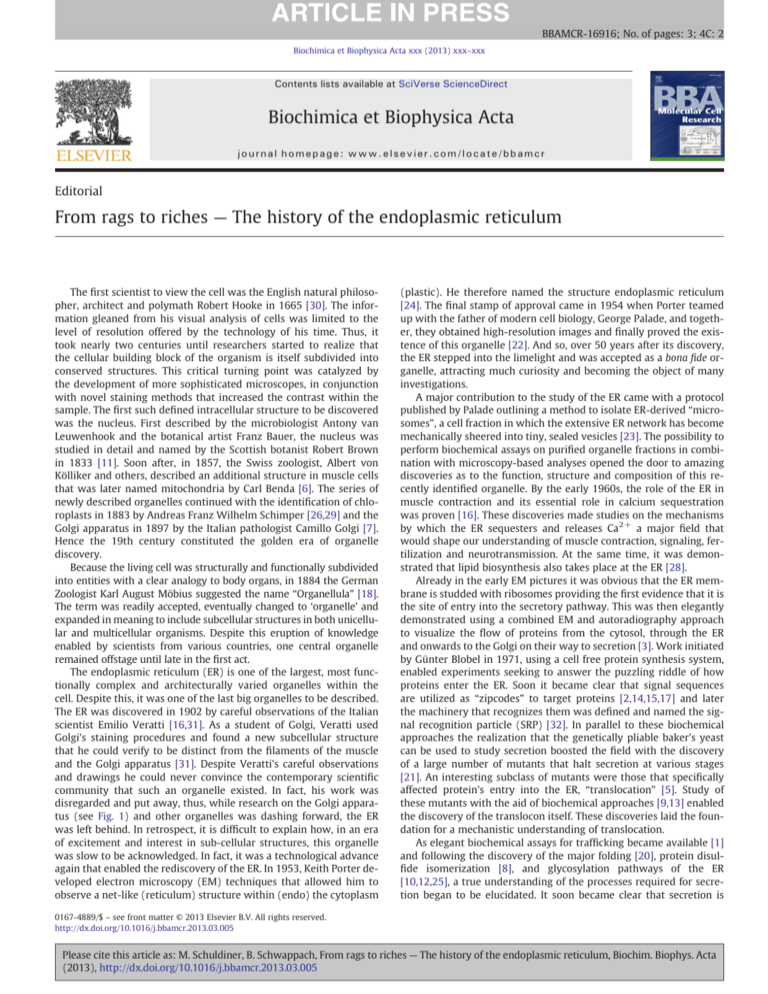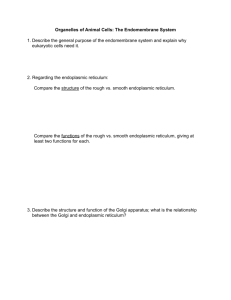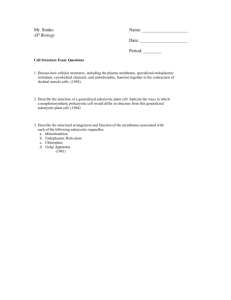
BBAMCR-16916; No. of pages: 3; 4C: 2
Biochimica et Biophysica Acta xxx (2013) xxx–xxx
Contents lists available at SciVerse ScienceDirect
Biochimica et Biophysica Acta
journal homepage: www.elsevier.com/locate/bbamcr
Editorial
From rags to riches — The history of the endoplasmic reticulum
The first scientist to view the cell was the English natural philosopher, architect and polymath Robert Hooke in 1665 [30]. The information gleaned from his visual analysis of cells was limited to the
level of resolution offered by the technology of his time. Thus, it
took nearly two centuries until researchers started to realize that
the cellular building block of the organism is itself subdivided into
conserved structures. This critical turning point was catalyzed by
the development of more sophisticated microscopes, in conjunction
with novel staining methods that increased the contrast within the
sample. The first such defined intracellular structure to be discovered
was the nucleus. First described by the microbiologist Antony van
Leuwenhook and the botanical artist Franz Bauer, the nucleus was
studied in detail and named by the Scottish botanist Robert Brown
in 1833 [11]. Soon after, in 1857, the Swiss zoologist, Albert von
Kölliker and others, described an additional structure in muscle cells
that was later named mitochondria by Carl Benda [6]. The series of
newly described organelles continued with the identification of chloroplasts in 1883 by Andreas Franz Wilhelm Schimper [26,29] and the
Golgi apparatus in 1897 by the Italian pathologist Camillo Golgi [7].
Hence the 19th century constituted the golden era of organelle
discovery.
Because the living cell was structurally and functionally subdivided
into entities with a clear analogy to body organs, in 1884 the German
Zoologist Karl August Möbius suggested the name “Organellula” [18].
The term was readily accepted, eventually changed to ‘organelle’ and
expanded in meaning to include subcellular structures in both unicellular and multicellular organisms. Despite this eruption of knowledge
enabled by scientists from various countries, one central organelle
remained offstage until late in the first act.
The endoplasmic reticulum (ER) is one of the largest, most functionally complex and architecturally varied organelles within the
cell. Despite this, it was one of the last big organelles to be described.
The ER was discovered in 1902 by careful observations of the Italian
scientist Emilio Veratti [16,31]. As a student of Golgi, Veratti used
Golgi's staining procedures and found a new subcellular structure
that he could verify to be distinct from the filaments of the muscle
and the Golgi apparatus [31]. Despite Veratti's careful observations
and drawings he could never convince the contemporary scientific
community that such an organelle existed. In fact, his work was
disregarded and put away, thus, while research on the Golgi apparatus (see Fig. 1) and other organelles was dashing forward, the ER
was left behind. In retrospect, it is difficult to explain how, in an era
of excitement and interest in sub-cellular structures, this organelle
was slow to be acknowledged. In fact, it was a technological advance
again that enabled the rediscovery of the ER. In 1953, Keith Porter developed electron microscopy (EM) techniques that allowed him to
observe a net-like (reticulum) structure within (endo) the cytoplasm
(plastic). He therefore named the structure endoplasmic reticulum
[24]. The final stamp of approval came in 1954 when Porter teamed
up with the father of modern cell biology, George Palade, and together, they obtained high-resolution images and finally proved the existence of this organelle [22]. And so, over 50 years after its discovery,
the ER stepped into the limelight and was accepted as a bona fide organelle, attracting much curiosity and becoming the object of many
investigations.
A major contribution to the study of the ER came with a protocol
published by Palade outlining a method to isolate ER-derived “microsomes”, a cell fraction in which the extensive ER network has become
mechanically sheered into tiny, sealed vesicles [23]. The possibility to
perform biochemical assays on purified organelle fractions in combination with microscopy-based analyses opened the door to amazing
discoveries as to the function, structure and composition of this recently identified organelle. By the early 1960s, the role of the ER in
muscle contraction and its essential role in calcium sequestration
was proven [16]. These discoveries made studies on the mechanisms
by which the ER sequesters and releases Ca 2+ a major field that
would shape our understanding of muscle contraction, signaling, fertilization and neurotransmission. At the same time, it was demonstrated that lipid biosynthesis also takes place at the ER [28].
Already in the early EM pictures it was obvious that the ER membrane is studded with ribosomes providing the first evidence that it is
the site of entry into the secretory pathway. This was then elegantly
demonstrated using a combined EM and autoradiography approach
to visualize the flow of proteins from the cytosol, through the ER
and onwards to the Golgi on their way to secretion [3]. Work initiated
by Günter Blobel in 1971, using a cell free protein synthesis system,
enabled experiments seeking to answer the puzzling riddle of how
proteins enter the ER. Soon it became clear that signal sequences
are utilized as “zipcodes” to target proteins [2,14,15,17] and later
the machinery that recognizes them was defined and named the signal recognition particle (SRP) [32]. In parallel to these biochemical
approaches the realization that the genetically pliable baker's yeast
can be used to study secretion boosted the field with the discovery
of a large number of mutants that halt secretion at various stages
[21]. An interesting subclass of mutants were those that specifically
affected protein's entry into the ER, “translocation” [5]. Study of
these mutants with the aid of biochemical approaches [9,13] enabled
the discovery of the translocon itself. These discoveries laid the foundation for a mechanistic understanding of translocation.
As elegant biochemical assays for trafficking became available [1]
and following the discovery of the major folding [20], protein disulfide isomerization [8], and glycosylation pathways of the ER
[10,12,25], a true understanding of the processes required for secretion began to be elucidated. It soon became clear that secretion is
0167-4889/$ – see front matter © 2013 Elsevier B.V. All rights reserved.
http://dx.doi.org/10.1016/j.bbamcr.2013.03.005
Please cite this article as: M. Schuldiner, B. Schwappach, From rags to riches — The history of the endoplasmic reticulum, Biochim. Biophys. Acta
(2013), http://dx.doi.org/10.1016/j.bbamcr.2013.03.005
2
Editorial
Fig. 1. The number of manuscripts published each year since the discovery of each of the two organelles — the Golgi apparatus (since 1898) and the endoplasmic reticulum (ER)
(since 1902).
quality controlled, i.e. that proteins only exit the ER after they have
reached their native tertiary and quaternary state.
As the field of ER studies was maturing, two major discoveries
propelled it into the limelight of a vast number of cell biological explorations: the characterization of the machineries required for the
unfolded protein response (UPR) [4,19,27] and ER associated degradation (ERAD) (see the historic review on ERAD in this issue). The
identification of these two pathways brought about the understanding that each step of protein secretion is tightly regulated and controlled: proteins don't just “flow” through the ER, rather this
organelle plays an active role in the folding, assembly and posttranslational modification of secretory proteins. This brought about a wave
of studies focusing on how ER functions take part in controlling development and highlighted the link between ER misregulation and a
large variety of diseases ranging from diabetes to cancer. Interestingly, in correlation with the discovery of the UPR and ERAD, the year
1997 marked a turning point in which the number of manuscripts
published about the ER rose above those published about the Golgi
apparatus and continues to rise to this day (Fig. 1).
And so, since its discovery more than a hundred years ago the ER
has taken its place as a key protagonist in cellular organization and
function. Each year reveals new fascinating facets of ER function and
regulation as well as the secrets of how it creates and maintains its intricate structure. The last decade has also demonstrated that the ER
plays a central role in inter-organelle communication by hosting contact sites with all other intracellular organelles. With the advent of
systematic approaches to biological processes and the development
of the field of functional genomics, studies on ER function and homeostasis have progressed even faster. However, more than half of ER
proteins are poorly characterized indicating that many exciting
years of discovery still lie ahead. This issue on many of the functions
of the ER is a celebration to this unique organelle that serves as a
hub for folding, lipid biosynthesis, ion homeostasis and intracellular
communication between organelles.
Acknowledgements
MS is supported by an ERC StG (260395). We thank Peter Walter,
Jeffrey Brodsky, Jonathan Weissman, Oren Schuldiner, Yifat Cohen,
Ido Yofe, Silvia Chuartzman, Tslil Ast, Shai Fuchs and Detlef Doenecke
for critical reading of the manuscript.
References
[1] W.E. Balch, B.S. Glick, J.E. Rothman, Sequential intermediates in the pathway of
intercompartmental transport in a cell-free system, Cell 39 (1984) 525–536.
[2] G. Blobel, D.D. Sabatini, Ribosome–membrane interaction in eukaryotic cells,
Biomembranes 2 (1971) 193–195.
[3] L.G. Caro, G.E. Palade, Protein synthesis, storage, and discharge in the pancreatic
exocrine cell. An autoradiographic study, J. Cell Biol. 20 (1964) 473–495.
[4] J.S. Cox, C.E. Shamu, P. Walter, Transcriptional induction of genes encoding endoplasmic reticulum resident proteins requires a transmembrane protein kinase,
Cell 73 (1993) 1197–1206.
[5] R.J. Deshaies, R. Schekman, A yeast mutant defective at an early stage in import of
secretory protein precursors into the endoplasmic reticulum, J. Cell Biol. 105
(1987) 633–645.
[6] L. Ernster, G. Schatz, Mitochondria: a historical review, J. Cell Biol. 91 (1981) 227s–255s.
[7] M.G. Farquhar, G.E. Palade, The Golgi apparatus: 100 years of progress and controversy, Trends Cell Biol. 8 (1998) 2–10.
[8] R.B. Freedman, Protein disulfide isomerase: multiple roles in the modification of
nascent secretory proteins, Cell 57 (1989) 1069–1072.
[9] D. Gorlich, S. Prehn, E. Hartmann, J. Herz, A. Otto, R. Kraft, M. Wiedmann, S.
Knespel, B. Dobberstein, T.A. Rapoport, The signal sequence receptor has a second
subunit and is part of a translocation complex in the endoplasmic reticulum as
probed by bifunctional reagents, J. Cell Biol. 111 (1990) 2283–2294.
[10] C. Gottlieb, J. Baenziger, S. Kornfeld, Deficient uridine diphosphate-Nacetylglucosamine:glycoprotein N-acetylglucosaminyltransferase activity in
a clone of Chinese hamster ovary cells with altered surface glycoproteins,
J. Biol. Chem. 250 (1975) 3303–3309.
[11] H. Harris, The Birth of the Cell, Yale University Press, 2000.
[12] F.W. Hemming, The role of polyprenol-linked sugars in eukaryotic macromolecular synthesis, Biochem. Soc. Trans. 5 (1977) 1682–1687.
[13] U.C. Krieg, A.E. Johnson, P. Walter, Protein translocation across the endoplasmic
reticulum membrane: identification by photocross-linking of a 39-kD integral
membrane glycoprotein as part of a putative translocation tunnel, J. Cell Biol.
109 (1989) 2033–2043.
[14] M. Leslie, Lost in translation: the signal hypothesis, J. Cell Biol. 170 (2005) 338.
[15] K.S. Matlin, Spatial expression of the genome: the signal hypothesis at forty, Nat.
Rev. Mol. Cell Biol. 12 (2011) 333–340.
[16] P. Mazzarello, A. Calligaro, V. Vannini, U. Muscatello, The sarcoplasmic reticulum:
its discovery and rediscovery, Nat. Rev. Mol. Cell Biol. 4 (2003) 69–74.
[17] C. Milstein, G.G. Brownlee, T.M. Harrison, M.B. Mathews, A possible precursor of
immunoglobulin light chains, Nat. New Biol. 239 (1972) 117–120.
[18] K.A. Möbius, Das Sterben der einzelligen und der vielzelligen Tiere. Vergleichend
betrachtet, Biol. Zent. Bl. 4 (1884) 389–392.
[19] K. Mori, W. Ma, M.J. Gething, J. Sambrook, A transmembrane protein with a
cdc2+/CDC28-related kinase activity is required for signaling from the ER to
the nucleus, Cell 74 (1993) 743–756.
[20] S. Munro, H.R. Pelham, An Hsp70-like protein in the ER: identity with the 78 kd
glucose-regulated protein and immunoglobulin heavy chain binding protein,
Cell 46 (1986) 291–300.
[21] P. Novick, R. Schekman, Secretion and cell-surface growth are blocked in a
temperature-sensitive mutant of Saccharomyces cerevisiae, Proc. Natl. Acad.
Sci. U.S.A. 76 (1979) 1858–1862.
[22] G.E. Palade, K.R. Porter, Studies on the endoplasmic reticulum. I. Its identification
in cells in situ, J. Exp. Med. 100 (1954) 641–656.
Please cite this article as: M. Schuldiner, B. Schwappach, From rags to riches — The history of the endoplasmic reticulum, Biochim. Biophys. Acta
(2013), http://dx.doi.org/10.1016/j.bbamcr.2013.03.005
Editorial
[23] G.E. Palade, P. Siekevitz, Liver microsomes; an integrated morphological and biochemical study, J. Biophys. Biochem. Cytol. 2 (1956) 171–200.
[24] K.R. Porter, Observations on a submicroscopic basophilic component of cytoplasm, J. Exp. Med. 97 (1953) 727–750.
[25] H. Schachter, The subcellular sites of glycosylation, Biochem. Soc. Symp. 57–71 (1974).
[26] A.F.W. Schimper, Über die Entwicklung der Chlorophyllkörner und Farbkörper,
Bot. Ztg. 41 (1883) 105–162.
[27] C.E. Shamu, J.S. Cox, P. Walter, The unfolded-protein-response pathway in yeast,
Trends Cell Biol. 4 (1994) 56–60.
[28] O. Stein, Y. Stein, Lipid synthesis, intracellular transport, storage, and secretion. I. Electron microscopic radioautographic study of liver after injection of tritiated palmitate
or glycerol in fasted and ethanol-treated rats, J. Cell Biol. 33 (1967) 319–339.
[29] E. Strassburger, F. Noll, H.C. Porter, H. Schenck, A.F.W. Schimper, A Text-book of
Botany, Macmillan, 1898.
[30] W. Turner, The cell theory, past and present, J. Anat. Physiol. 24 (1890) 253–287.
[31] E. Veratti, Investigations on the fine structure of striated muscle fiber read before
the Reale Istituto Lombardo, 13 March 1902, J. Biophys. Biochem. Cytol. 10 (4)
(1961) 1–59, [Suppl.].
[32] P. Walter, R. Gilmore, M. Muller, G. Blobel, The protein translocation machinery of the
endoplasmic reticulum, Philos. Trans. R. Soc. Lond. B Biol. Sci. 300 (1982) 225–228.
Dr. Maya Schuldiner was born in Israel. She completed two
years of military service in 1996, and graduated magna cum
laude with a BSc in Biology from the Hebrew University in
Jerusalem in 1998. She went on to complete both her MSc
and a PhD in genetics, also at the Hebrew University, in
1999 and 2003. She conducted postdoctoral research in the
Department of Cellular and Molecular Pharmacology at the
University of California in San Francisco from 2003 until
2008, when she joined the faculty of the Weizmann Institute
of Science.
3
Dr. Blanche Schwappach was born in Germany and graduated with a diploma in biology (biophysics/biochemistry)
from the University of Konstanz in 1992. She went on to
complete her PhD at the Center for Molecular Neurobiology
in Hamburg in 1996. She conducted postdoctoral research
in the Departments of Biochemistry and Physiology at the
University of California in San Francisco from 1996 to 2000.
Next, she joined first the Center for Molecular Biology in
Heidelberg and then the Faculty of Life Sciences at the
University of Manchester as a principal investigator. In
2010 she took up a Chair of Biochemistry at the University
of Göttingen Medical Center.
Maya Schuldiner
Department of Molecular Genetics, Weizmann Institute of Science,
Rehovot 76100, Israel
Corresponding author. Tel.: +972 8 9346346.
E-mail address: maya.schuldiner@weizmann.ac.il.
Blanche Schwappach
Department of Biochemistry I, Faculty of Medicine,
University of Göttingen, Humboldtallee 23, 37073 Göttingen, Germany
Available online xxxx
Please cite this article as: M. Schuldiner, B. Schwappach, From rags to riches — The history of the endoplasmic reticulum, Biochim. Biophys. Acta
(2013), http://dx.doi.org/10.1016/j.bbamcr.2013.03.005







